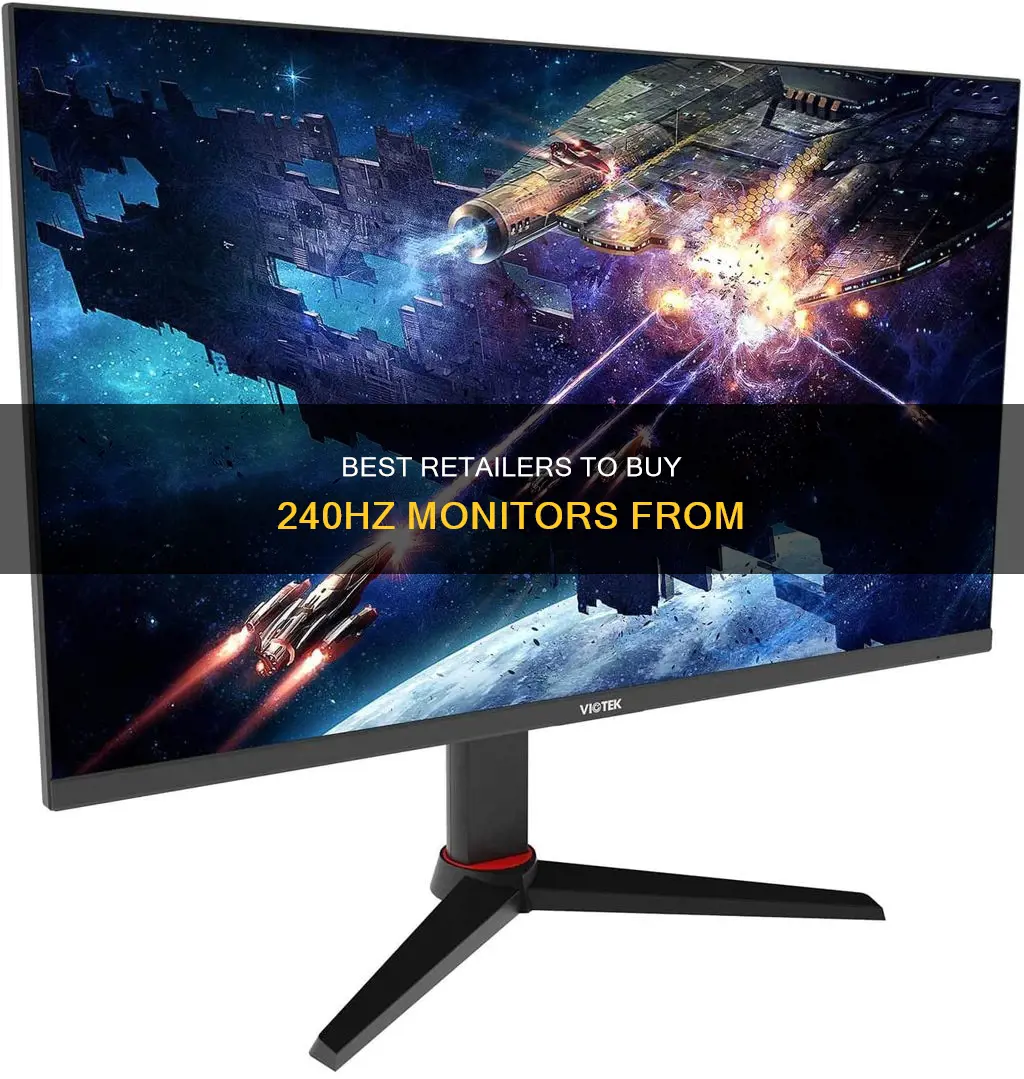
If you're looking to buy a 240Hz monitor, you've got plenty of options. A high refresh rate monitor is great for gaming, providing better motion handling and lower input lag. While there are displays with even higher refresh rates, these tend to be more expensive. You can find 240Hz monitors at various price points and resolutions, from 1080p to 4K.
Some of the best 240Hz monitors available include the Samsung Odyssey OLED G8, the ASUS ROG Strix OLED XG27AQDMG, the ASUS ROG Swift PG279QM, and the ViewSonic XG2431. You can buy these monitors from online retailers like Amazon, Best Buy, and eBay.
| Characteristics | Values |
|---|---|
| Monitor Brand | Samsung, LG, Alienware, Acer, ASUS, AOC, HP, Dell, Sceptre, KOORUI, Z-Edge, BenQ, GreBear, Sony, MSI, Sansui, GTEK |
| Display Size | 24.5", 25", 27", 31.5", 31.6", 32", 39", 45", 49", 57" |
| Resolution | FHD 1080p, QHD 1440p, QHD Wide 1440p, WQHD, 4K, 4K@240Hz |
| Response Time | 0.5ms, 1ms, 1.0ms, 0.03ms, 0.5ms-1ms |
| Refresh Rate | 240Hz, 280Hz, 360Hz, 480Hz |
| HDR | HDR, HDR10, HDR400, DisplayHDR 400, HDR350, HDR 400 True Black |
| Ports | HDMI, DisplayPort, USB, USB-C, USB-A, USB-B, USB 3.0, USB 3.2, USB 2.0, DisplayPort 1.4, DisplayPort 2.1, mini DP 2.1, VGA, DP, DVI, Thunderbolt |
| Other Features | AMD FreeSync, NVIDIA G-SYNC, G-SYNC Compatible, G-SYNC Compatible and AMD FreeSync Premium, AMD Adaptive Sync, AMD FreeSync Premium, NVIDIA Adaptive Sync, KVM switch, Quantum Mini-LED, Quantum Dot, QD-OLED, OLED, Glossy Coating, Matte Coating, Curved, Dual Mode, Dual QHD, WQHD |
What You'll Learn

Best 240Hz Gaming Monitors
If you're looking for a 240Hz gaming monitor, there are several options available depending on your budget and preferences. Here are some of the best 240Hz gaming monitors currently on the market:
Samsung Odyssey OLED G8/G80SD S32DG80
This is the best 240Hz gaming monitor according to RTINGS.com. It offers high-end performance and outstanding picture quality with a 4k resolution and a 240Hz refresh rate. It has a near-instantaneous response time, resulting in minimal motion blur, and supports HDMI 2.1 bandwidth for modern graphics cards. Its QD-OLED panel delivers deep blacks and bright colours, making it suitable for both dark and well-lit rooms.
ASUS ROG Strix OLED XG27AQDMG
If you're looking for something a little more affordable, the ASUS ROG Strix OLED XG27AQDMG is a great option. It's the best 1440p 240Hz monitor according to RTINGS.com. While it doesn't have the same high resolution as the Samsung Odyssey, it's easier for your graphics card to maintain a high frame rate. It uses an OLED panel with deep blacks and delivers a satisfying HDR experience. It has a glossy screen coating, making images clearer but reflections more distracting. It also has a near-instantaneous response time, resulting in minimal motion blur.
ASUS ROG Swift PG279QM
For an even more affordable option, the ASUS ROG Swift PG279QM is a good choice. While it doesn't have an OLED panel, it's still a great gaming monitor with native G-SYNC support. It has a consistently fast response time at any refresh rate, but there is a bit more blur compared to OLED screens. Like the XG27AQDMG, it requires a DisplayPort connection to take full advantage of the monitor.
Gigabyte M27Q X
If you're looking for a lower mid-range option, the Gigabyte M27Q X is a great choice. It has a fast response time and is G-SYNC compatible, working well with NVIDIA graphics cards. It also has a backlight strobing feature that helps reduce persistence blur, and it works simultaneously with VRR. It has a 27" IPS display with a sharp 1440p resolution, offering a balance between size and clarity for your games. It also has excellent colour accuracy and vibrancy, bringing your games to life with rich, vivid colours and deep contrasts.
ViewSonic XG2431
If you're on a tight budget, the ViewSonic XG2431 is a fantastic option. It has a lower resolution, making it easier for your graphics card to maintain a high frame rate, and a smaller 24-inch screen. It offers great motion handling with minimal motion blur and a customizable backlight strobing feature to reduce persistence blur.
You can find these monitors at online retailers like Amazon, Best Buy, and eBay, as well as from specific brands like Dell and Acer.
Troubleshooting Black-Screen Issues on LCD Monitors
You may want to see also

240Hz Monitor Deals
If you're looking to buy a 240Hz monitor, there are plenty of options available, with some offering better value than others.
Best Budget 240Hz Monitor
The AOC C27G2Z is an excellent choice for competitive gamers. It has a 240Hz refresh rate, a lightning-quick 0.5ms response time, and FreeSync Premium, all for a very reasonable price. The VA panel delivers deeper blacks for a more immersive viewing experience, but you may experience some dark-level smearing. The stand is fully adjustable, and it has rich connectivity, including HDMI and DisplayPort.
Best Budget 1440p 240Hz Monitor
The Acer Nitro XV272U W2bmiiprx is an excellent choice if your gaming rig can handle 240Hz at 1440p. It's one of the cheapest 1440p monitors with a 240Hz refresh rate, and it doesn't compromise on gaming performance and image quality. The Nitro XV272U W2bmiiprx uses an IPS panel, so colours are accurate and uniform, and it has a lightning-fast 0.5ms response time. At 27 inches, the 1440p resolution produces sharp and clean images.
Best Affordable 24-inch 240Hz Monitor
The Sceptre C255B-FWT240 is the perfect choice if you're short on space or want the cheapest 240Hz monitor for competitive gaming. It has a 240Hz refresh rate, a fast 1ms response time, and FreeSync and G-Sync compatibility. The smaller size means you can see everything on the screen at once without panning, and the curved screen adds to the immersion.
Best Overclockable 240Hz Monitor
The ASUS TUF Gaming VG279QM is a 240Hz monitor that can be overclocked to 280Hz, delivering a faster and more responsive gaming experience. It also has a powerful backlight strobing feature that eliminates motion blur. It has G-Sync compatibility, excellent in-game enhancements, and good colour accuracy and wide viewing angles. The stand is fully adjustable, and you can get the full 240Hz refresh rate via HDMI or DisplayPort.
Best Budget 240Hz Monitor Without a Curved Display
The Sceptre E275B-FWD240 is a great choice if you prefer flat monitors. It has a 240Hz refresh rate, a 1ms response time, and FreeSync Premium support. The resolution is 1080p, and the screen size is 27 inches, which is still sharp enough for most people. It has 99% sRGB, so colour accuracy is not an issue, and it has RGB lighting for added immersion. It also has a fully adjustable stand and decent built-in speakers.
Best Budget 32-inch 240Hz Monitor
The AOC C32G2ZE is a great choice if you want a bigger, curved, and immersive display. It has a 240Hz refresh rate, incredibly low input, and a lightning-quick 1ms response time. AOC has added some handy in-game enhancements, such as crosshairs and a shadow boost feature. The 32-inch curved panel covers up to 95.6% of the DCI-P3 colour gamut, producing rich and vivid colours.
Other Options
Other options for 240Hz monitors include the ViewSonic XG2530, which is a great value choice for gamers wanting a FreeSync-compatible monitor. It has a 1ms response time, a 3-year warranty, and an ergonomically designed stand.
The LG UltraGear 27" FHD is another affordable option with an IPS display, a 1ms response time, and a 240Hz refresh rate for a fluid viewing experience. It has sRGB 99% coverage, making it ideal for artwork as well as gaming.
The Alienware 240Hz Gaming Monitor is another excellent choice for gamers seeking fluid images and smoothness. It has a fully adjustable lighting system with dynamic lighting effects and full RGB values. The 27" screen lets you see everything at once, and the native FHD resolution keeps games running in 1080p precise and quick.
Lastly, the Lenovo Legion Y25-25 is a good option if you want a 240Hz monitor for both leisure and competitive gaming. It's a Full HD LED-backlit monitor with a fast refresh rate and low response rate, and it has excellent connectivity options.
Understanding FPS Mode on Your ASUS Monitor
You may want to see also

240Hz Monitor Reviews
Best Overall 240Hz Monitor
The Asus ROG Swift PG32UCDP is a 4K monitor with a 480Hz refresh rate and a 0.03ms response time. It features a bright WOLED panel with a native 4K resolution, deep, black-as-pitch contrast, and excellent HDR content performance. It also has a built-in KVM, making it possible to connect two devices simultaneously. It is compatible with Nvidia G-Sync and AMD FreeSync.
Best Budget 240Hz Monitor
The ViewSonic XG2431 is a 1080p display with a 240Hz refresh rate and a 1ms response time. It was the first gaming monitor to receive the Blur Busters Approved 2.0 certification for its PureXP backlight strobing technology. It supports AMD FreeSync with a 48-240Hz VRR range and offers stable VRR performance with NVIDIA cards. It also has a fully ergonomic stand and a dual-USB 3.0 hub.
Best 1440p 240Hz Monitor
The AOC Agon Pro AG276QZD2 is a 1440p monitor with a QD-OLED panel,
Monitoring Bandwidth Usage on Your iPad: A Step-by-Step Guide
You may want to see also

240Hz Monitor Buying Guide
A 240Hz monitor is a great investment for gamers, offering a higher refresh rate and smoother, more responsive gameplay. If you're in the market for a 240Hz monitor, there are a few things to consider to ensure you get the best model for your needs.
Type of Gaming Setup
First, think about your gaming setup. If you have a high-end graphics card that can maintain 240 fps with a high resolution, opt for a 1440p or 4k monitor to take full advantage of your hardware. On the other hand, if you're working with a budget setup, a low-cost 1080p monitor will be a better choice.
Resolution
The resolution of your monitor will depend on your preferences and how you intend to use it. If you're primarily interested in competitive gaming, a lower resolution like 1080p may be sufficient, especially if you're on a budget. However, if you want sharper, more detailed images, consider a higher resolution like 1440p or 4k. Keep in mind that higher resolutions will require more powerful hardware to run smoothly.
Screen Size
The size of your monitor will impact your gaming experience and immersion. Larger screens, such as 27-inch or 32-inch models, can offer a more immersive gaming experience, but they also take up more space. If you have limited desk space or prefer a more compact setup, a smaller 24-inch monitor might be a better option.
Panel Type
The type of panel used in your monitor will affect image quality, colour accuracy, and viewing angles. There are three main types of panels: TN, IPS, and VA. TN panels tend to have faster response times and lower input lag, making them popular among competitive gamers, but they often have inferior image quality and narrower viewing angles. IPS panels offer better colour accuracy and wider viewing angles, making them a good choice for those who want a balance between performance and image quality. VA panels provide deep blacks and high contrast ratios, resulting in immersive visuals, but they may suffer from VRR brightness flickering in games with fluctuating frame rates.
Additional Features
When choosing a 240Hz monitor, consider additional features that can enhance your gaming experience. Look for models with VRR (Variable Refresh Rate) and MBR (Motion Blur Reduction) support, as these technologies help reduce screen tearing and motion blur, respectively. If you want to connect multiple devices to your monitor, look for models with a KVM (Keyboard, Video, Mouse) switch, which allows you to easily switch between different computers using the same keyboard and mouse. Other features to consider include built-in speakers, USB hubs, and ergonomic stands that offer height adjustment and tilt capabilities.
Budget
Finally, consider your budget. 240Hz monitors can vary significantly in price, depending on the features and specifications. If you're looking for a high-end model with all the latest features, be prepared to invest a significant amount. However, if you're on a tight budget, there are still some great options available, such as the ViewSonic XG2431, which offers excellent motion handling and a customizable backlight strobing feature.
Recommendations
- Best Overall 240Hz Gaming Monitor: Asus ROG Swift PG32UCDP. It offers a bright WOLED panel with native 4K resolution, excellent responsiveness, and a host of gaming features.
- Best Budget 240Hz Gaming Monitor: Gigabyte M27Q X. This monitor strikes a great balance between stunning visuals, fast performance, and versatile features, all at a more affordable price point.
- Best 1440p 240Hz Gaming Monitor: AOC Agon Pro AG276QZD2. This monitor combines a QD-OLED panel with quantum dots for exceptional colours and HDR performance, all at a very competitive price.
- Best Ultrawide 240Hz Gaming Monitor: Asus ROG Swift PG34WCDM. With its deep-dish curve, high-end OLED panel, and immersive picture quality, this monitor delivers an exceptional gaming experience.
Where to Buy
You can find 240Hz monitors at various online retailers, including Amazon, Best Buy, and eBay. Additionally, specialised websites like RTINGS.com and DisplayNinja provide in-depth reviews and buying guides to help you make an informed decision.
Remember to consider your specific needs, budget, and the features that are most important to you when choosing a 240Hz monitor.
Understanding Vivid Pixels on ASUS Monitors: Feature or Flaw?
You may want to see also

240Hz Monitor FAQs
If you're a gamer, you might be wondering whether to invest in a 240Hz monitor with a lower resolution or a 4K monitor with a lower refresh rate. If visual fidelity and immersion are your top priorities, a 4K monitor is likely the better option. However, if performance and reaction time are key, a monitor with a higher refresh rate will give you the advantage. It is possible to get a 4K monitor that runs at 240Hz, but it will cost you.
If you want exceptionally low input latency, high responsiveness, and superior motion clarity—especially in competitive esports where every millisecond counts—then a 240Hz gaming monitor is definitely worth it. If you're not a competitive player and aren't sensitive to motion clarity, the benefits will be less noticeable. Generally, upgrading to refresh rates beyond 144Hz becomes less noticeable each time.
Yes, but beyond 144Hz, you'll experience diminishing returns. A 360Hz monitor is measurably faster, has less input latency, and offers slightly better motion clarity. However, the difference in what you'll experience while gaming isn't massive and will be most noticeable in competitive shooters.
240Hz monitors are some of the best displays for high-response-rate gaming, but they come with a hefty price tag. While you can cut costs by looking at lower resolutions, you can also find discounts during annual sales events like Amazon Prime Day and Black Friday. 240Hz displays may also go on sale when tech companies release new 360Hz models.
Monitor Size: Does Scale Impact Studio Performance?
You may want to see also







